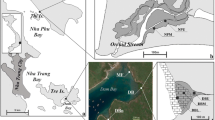Abstract
The Godavari estuarine system extending over approximately 316 km2 has significant annual variation of salinity due to seasonal flooding which is mainly monsoon fed. This area has dense vegetation of mangroves and is characterised by predominance of Avicennia sp. Excoecaria agallocha and Rhizophora sp. In the coastal waters adjacent to the mangroves three economically important species of prawns occur (Penaeus monodon, P. indicus and Metapenaeus monoceros). Their larvae migrate and dwell in the mangrove environment. By analysis for the natural stable carbon isotope ratios, it was possible to establish the primary carbon source from the mangroves to that of larvae and juveniles of P. indicus and P. monodon. This information can be used to exploit the mangrove habitat as prawn nurseries.
Access this chapter
Tax calculation will be finalised at checkout
Purchases are for personal use only
Preview
Unable to display preview. Download preview PDF.
Similar content being viewed by others
References
Benner, R., E. R. Peele & E. Hodson, 1986. Microbial utilization of dissolved organic matter from leaves of the red mangrove Rhizophora mangle, in the Fresh Creek estuary, Bahamas, Estuar. coast. Shelf Sci. 23: 607–619.
Blaber, S. J. M., D. T. Brewer & J. P. Salini, 1989. Species composition and biomass of fishes in different habitats of a tropical northern Australian Estuary: their occurence in the adjoining sea and estuarine dependence, Estuar. coast. Shelf Sci. 29: 509–531.
Day, J. H., S. J. M. Blaber & J. H. Wallace, 1981. Estuarine Ecology with particular reference to Southern Africa, Balkema, Cape Town: 197–221.
Fontugne, M. R. & J.-C. Duplessy, 1981. Organic carbon isotopic fractionation by marine plankton in the temperature range — 1 to 31°C, Oceanol. Acta 4: 85–90.
Hemminga, M. A., E J. Slim, J. Kazungu, G. M. Ganssen, J. Nieuwenhuize & N. M. Kruyt, 1994. Carbon outwelling from a mangrove forest with adjacent seagrass beds and coral reefs (Gazi Bay, Kenya ), Mar. Ecol. Progr. Ser. 106: 291–301.
Macnae, W., 1974, Mangrove Forests and Fisheries. Indian Ocean Fisheries Commission IOFC/DEV/74, 34, FAO, Rome, 35 pp.
Odum, E. P., Fundamentals of Ecology, Saunders CO, 574 pp.
Odum, W. E., C. C. McIvor & T. J. Smith III, 1982. The ecology of mangroves of south Florida: a community profile, U.S. Fish. and Wild Life Service, Office of the Biological Services, Washington D.C., FWS/OBS 81 /24, 144 pp.
Primavera, J. H., 1996. Stable carbon and nitrogen isotope ratios of Penaeid juveniles and primary producers in a riverine mangrove in Guimaras, Philippines, Bull. mar. Sci. 58: 675–683.
Rao, R. G., A. F. Woitchik, L. Goeyens, A. van Riet, J. Kazungu & F. Dehairs, 1994. Carbon, nitrogen contents and stable carbon isotope abundance in mangrove leaves from an east African Coastal Lagoon (Kenya), Aquat. Bot. 47: 175–183.
Robertson, A. I. & N. C. Duke, 1987. Mangroves as nursery sites: comparisons of abundance and species composition of fish and crustaceans in mangroves and other nearshore habitats in tropical Australia. Mar. Biol. 93: 193–205.
Rodelli, M. R., J. N. Gearing, P. J. Gearing, N. Marshall & A. Sasekumar, 1984. Stable isotope ratio as a tracer of mangrove carbon in Malaysian ecosystems, Oecologia 61: 326–333.
Strickland, J. D. H. & T. R. Parsons, 1972. Standard Methods for the Examination of water and Wastewater ( 13th edn ). Am. Publ. Health Ass., Washington D.C., 874 pp.
Thayer, G. W., D. R. Colby & Hettler, 1987. Utilization of red mangrove prop root habitat by fishes in South Florida, Mar. Ecol. Progr. Series 35: 25–38.
Author information
Authors and Affiliations
Editor information
Rights and permissions
Copyright information
© 1997 Springer Science+Business Media Dordrecht
About this paper
Cite this paper
Mohan, P.C., Rao, R.G., Dehairs, F. (1997). Role of Godavari mangroves (India) in the production and survival of prawn larvae. In: Hagiwara, A., Snell, T.W., Lubzens, E., Tamaru, C.S. (eds) Live Food in Aquaculture. Developments in Hydrobiology, vol 124. Springer, Dordrecht. https://doi.org/10.1007/978-94-017-2097-7_51
Download citation
DOI: https://doi.org/10.1007/978-94-017-2097-7_51
Publisher Name: Springer, Dordrecht
Print ISBN: 978-90-481-5003-8
Online ISBN: 978-94-017-2097-7
eBook Packages: Springer Book Archive




